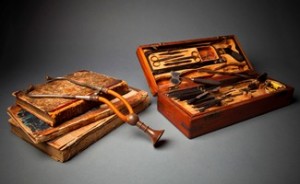A reminder of when doctors had a rudimentary understanding of human anatomy, performed surgery without antiseptic and used primitive forms of anesthesia for operations and dental work.

“Medical Treasures,” on display through October 2013, features materials from the WHSC Library’s historical collections, which include 18th- and 19th-century works on human anatomy, pathology, surgery, midwifery and alternative medical practices.
Dr. Robert Gaynes, professor of infectious disease at the Emory School of Medicine and author of the book “Germ Theory: Medical Pioneers in Infectious Diseases,” is the exhibition curator with Matt Miller, a resources management senior specialist at the WHSCL who earned his PhD in American Studies from Emory’s Graduate Institute of Liberal Arts.
“Emory has some really remarkable books and artifacts on the history of medicine, especially from the 1800s, when modern medicine got its start,” Gaynes says.
This is the first major exhibition for WHSC Library, says Sandra Franklin, the library’s director. “It’s really exciting for us to give visibility to our treasures,” she says. “The rareness of some of the pieces is amazing.”
Notable artifacts in the exhibition include one of the earliest stethoscopes from the 19th century, and a kit of Civil War surgeon’s instruments, primarily used for amputation. Materials related to the discovery of anesthesia are also part of the exhibition, including the notes of Crawford W. Long, the Georgia physician for whom Emory University Hospital Midtown was originally named.
Most of the materials on display are historical medical books. Among these volumes: books about Civil War field surgery practices, an 1881 book that incorporates early medical photography to show the ravages of syphilis, a copy of “Notes on Nursing: What It is, and What It Is Not” (1865) by Florence Nightingale. The last exhibition case is dedicated to a significant medical book: “De Humani Corporis Fabrica” (On the structure of the human body), first published by Andreas Vesalius in 1543. It is considered the first accurate book on human anatomy. The actual volume is available for viewing in Emory’sManuscript, Archives and Rare Book Library (MARBL).
Some of the rare books on display have been scanned through the Emory Libraries’ digitization program, and visitors will be able to “page through” these treasures, physically kept under glass, via a kiosk in the exhibition.
WHSC Library is located at 1462 Clifton Rd. The library’s webpage provides linksto directions, parking, hours and maps.
